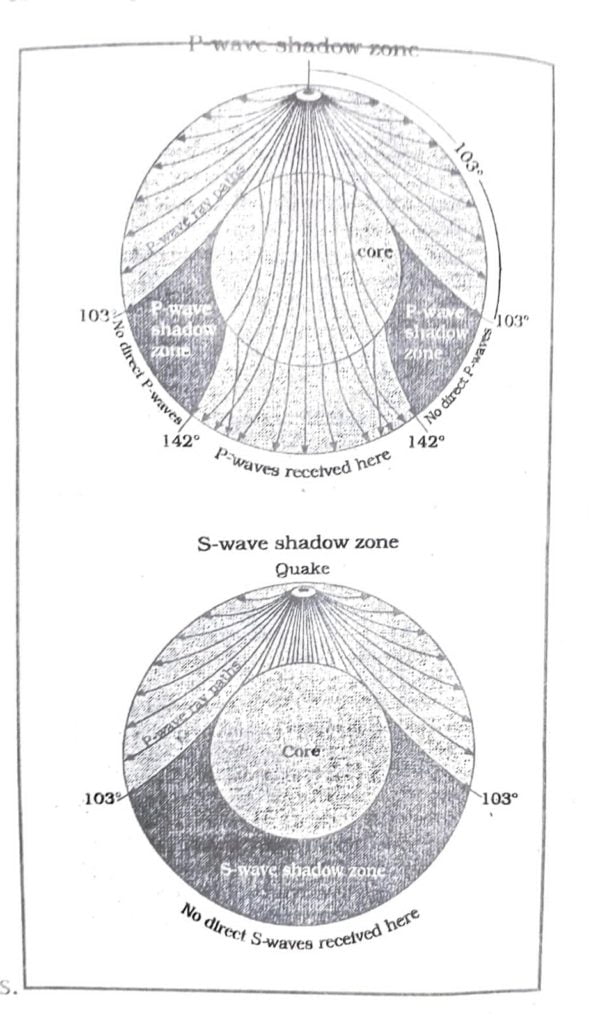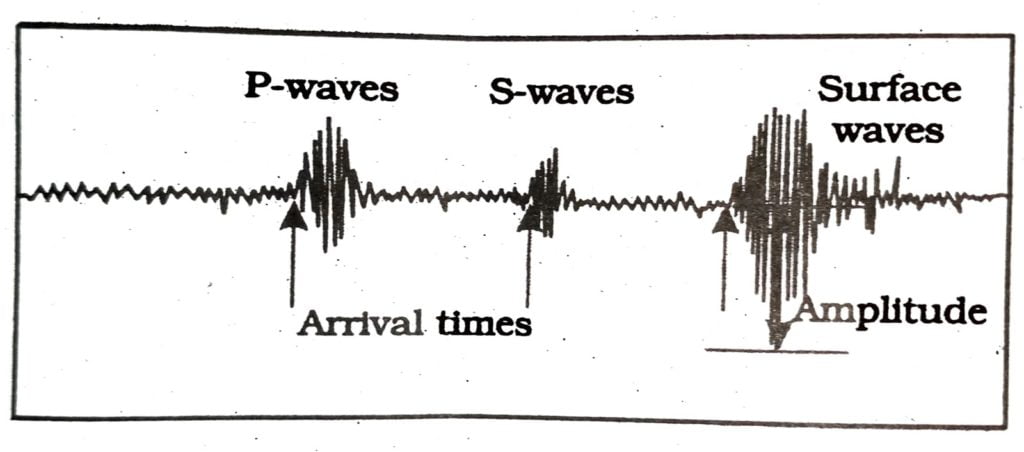Class 11 Geography Chapter 3 Interior of the Earth The answer to each chapter is provided in the list so that you can easily browse throughout different chapters SCERT Class 11 Geography Chapter 3 Interior of the Earth and select need one.
Class 11 Geography Chapter 3 Interior of the Earth
Also, you can read the SCERT book online in these sections Solutions by Expert Teachers as per SCERT (CBSE) Book guidelines. These solutions are part of SCERT All Subject Solutions. Here we have given Assam Board/NCERT Class 11 Geography Chapter 3 Interior of the Earth Solutions for All Subject, You can practice these here…
Interior of the Earth
Chapter: 3
PART-1
GEOGRAPHY
TEXTUAL QUESTION & ANSWER
(a) Multiple choice questions.
Q.1.Which one of the following earthquake waves is more destructive?
(i) P-waves
(ii) S-waves
(iii) Surface waves
(iv) None of the above
Ans: (iii) Surface waves
Q.2. Which one of the following is a direct source of information about the interior of the earth?
(i) Earthquake
(ii) Volcanoes
(iii) Gravitational force
(iv) Earth magnesium
Ans: (ii) Volcanoes
Q.3. Which type of volcanic eruptions have caused Deccan Trap formations?
(i) Shield
(ii) Flood
(iii) Composite
(iv) Caldera
Ans.(ii) Flood
Q.4. Which one of the following describes the lithosphere ?
(i) Upper and lower mantle
(ii) Crust and upper mantle
(iii) Crust and core
(iv) Mantle and core
Ans. (ii) Crust and upper mantle
(b) Answer the following questions in about 30 words.
Q.1. What are body waves?
Ans: At the time of Earthquake some waves originate, which are named as body waves and surface waves. Body waves are generated due to the release of energy at the focus and move in all directions travelling through the body of the earth. That is why it is named as body waves.
Q.2. Name the direct sources of information about the interior of the earth.
Ans: The direct sources of information about the interior of the earth are:
1.mines and
2. volcanic eruptions
From the mines of different parts of the world it is known that with increasing the depth of mines the temperature as well as the density of the matter are increased. It means the interior parts of the earth remain in hot conditions.
As and when the molten material (magma) is thrown onto the surface of the earth during volcanic eruption it becomes easy to estimate that the interior of the earth remains in hot and liquid conditions.
Q.3. Why do earthquake waves develop shadow zones?
Ans: The earthquake waves develop a shadow zone. Because of their curve direction. We know that the density of matter inside the earth is very from region to region. Beyond the depth of 2900km’S’ waves disappear while ‘P’ wave travel with reduced velocity.It was observed that seismographs located at any distance within 150 from the epicenter recorded the arrival of both ‘P’ and ‘S’ waves. However the seismographs located beyond 145 from epicenter, record the arrival of P-waves, but not that of S-waves. Thus a Zone between 105 and 145 from the epicenter was identified as the shadow zone for both the types of waves.

Q.4.Briefly explain the indirect sources of information of the interior of the earth other than those of seismic activity.
Ans: Other than the seismic activity; the direct sources of information of the interior of the earth are as follows:
1. Study of meteors
2. Gravitation
3. Magnetic field study etc.
1. Study of meteors: The material and the structure observed in the meteors are similar to that of the earth. They are solid bodies developed out of materials same as our earth. So,by studying the meteors we are able to know about the interior of the earth.
2. Gravitation: The gravitational force is not the same at different latitudes on the surfaces. The gravity values also differ according to the mass of material. By reading the gravity at different places provides information about the interior of the earth.
3. Magnetic field: Magnetic surveys also provide various information about the distribution of materials in the interior of the earth.
| Sl. No. | CONTENTS |
| Chapter 1 | Geography As A Discipline |
| Chapter 2 | The Origin and Evolution of the Earth |
| Chapter 3 | Interior of the Earth |
| Chapter 4 | Distribution of Oceans And Continents |
| Chapter 5 | Minerals and Rocks |
| Chapter 6 | Geomorphic Processes |
| Chapter 7 | Landforms and Their Evolution |
| Chapter 8 | Composition and Structure of Atmosphere |
| Chapter 9 | Solar Radiation, Heat balance, and Temperature |
| Chapter 10 | Atmospheric Circulation and Weather Systems |
| Chapter 11 | Water in the Atmosphere |
| Chapter 12 | World Climate and Climate Change |
| Chapter 13 | Water (Oceans) |
| Chapter 14 | Movements of Ocean Water |
| Chapter 15 | Life on the Earth |
| Chapter 16 | Biodiversity And Conservation |
| Chapter 17 | Indian Location |
| Chapter 18 | Structure and Physiography |
| Chapter 19 | Drainage System |
| Chapter 20 | Climate |
| Chapter 21 | Natural Vegetation |
| Chapter 22 | Soils |
| Chapter 23 | Natural Hazards and Disasters |
Answer the following questions in about 150 words
Q.1. What are the effects of propagation of earthquake waves on the rock mass through which they travel?
Ans: At the time of earthquake various waves are develop, which are named
1. P-waves.
2. S-waves.
3. Surface wave as shown in figure.

Earthquake waves travel in different manners. As they move or propagate they cause vibration in the body of the rocks through which they pass. P-waves vibrate parallel to the direction of the wave. This exerts pressure on the material in the direction of the propagation. As a result it crates density differences in the material leading to stretching and squeezing of the material. Other three waves vibrate perpendicular to the direction of propagation.
The direction of vibrations ofS- waves is perpendicular to the wave direction in the vertical plane. They created through and crests in the materials through which they pass.
The surface waves are considered to be the most damaging waves. Because at the time of their propagation they cause heavy displacements of the rock mass and collapse of structures. Some collapse structures are given below in figure.

Q.2.What do you understand by intrusive forms? Briefly describe various intrusive forms.
Ans: The lava that is released during volcanic eruptions on cooling develops into igneous rocks. The cooling may take place either on reaching the surface or also while the lava is still in the crustal portion. The lava that cools within the crustal portions assumes different forms. These forms are called intrusive forms.
The following are the noted intrusive forms in the crystal portions of the earth.

(a) Batholiths: A large body of magnetic material that cools in the deeper depth of the crust develops in the form of large domes. They cover large areas with several km depth. These are granitic bodies. They are cooled by magma chambers.
(b) Laccoliths: Laccoliths are large dome shaped intrusive bodies with a level base and connected by a pipe-like conduit from below. It resembles the surface volcanic domes of composite volcanoes.
(c) Laccolith: When the lava moves upwards a portion of the lava may tend to move in a horizontal direction whenever it finds a weak plane. When it develops into a saucer, concave to the sky body, such forms are termed as Lapolith.
(d) phacolith: Sometimes wavy masses of intrusive rocks are found at the base of synclines or at the top of anticlines in folded areas. Such wavy materials have a definite conduit to source beneath in the form of magma chambers. These are called phacoliths.
(c) sills: Depending upon the thickness of the intrusive igneous sheet or will they be called as sheets (thinner ones) and sills (thick horizontal deposits).
(d)Dykes: The wall- like intrusive structure are called as dykes
| Sl. No. | CONTENTS |
| Chapter 1 | Geography As A Discipline |
| Chapter 2 | The Origin and Evolution of the Earth |
| Chapter 3 | Interior of the Earth |
| Chapter 4 | Distribution of Oceans And Continents |
| Chapter 5 | Minerals and Rocks |
| Chapter 6 | Geomorphic Processes |
| Chapter 7 | Landforms and Their Evolution |
| Chapter 8 | Composition and Structure of Atmosphere |
| Chapter 9 | Solar Radiation, Heat balance, and Temperature |
| Chapter 10 | Atmospheric Circulation and Weather Systems |
| Chapter 11 | Water in the Atmosphere |
| Chapter 12 | World Climate and Climate Change |
| Chapter 13 | Water (Oceans) |
| Chapter 14 | Movements of Ocean Water |
| Chapter 15 | Life on the Earth |
| Chapter 16 | Biodiversity And Conservation |
| Chapter 17 | Indian Location |
| Chapter 18 | Structure and Physiography |
| Chapter 19 | Drainage System |
| Chapter 20 | Climate |
| Chapter 21 | Natural Vegetation |
| Chapter 22 | Soils |
| Chapter 23 | Natural Hazards and Disasters |

Hi, I’m Dev Kirtonia, Founder & CEO of Dev Library. A website that provides all SCERT, NCERT 3 to 12, and BA, B.com, B.Sc, and Computer Science with Post Graduate Notes & Suggestions, Novel, eBooks, Biography, Quotes, Study Materials, and more.


